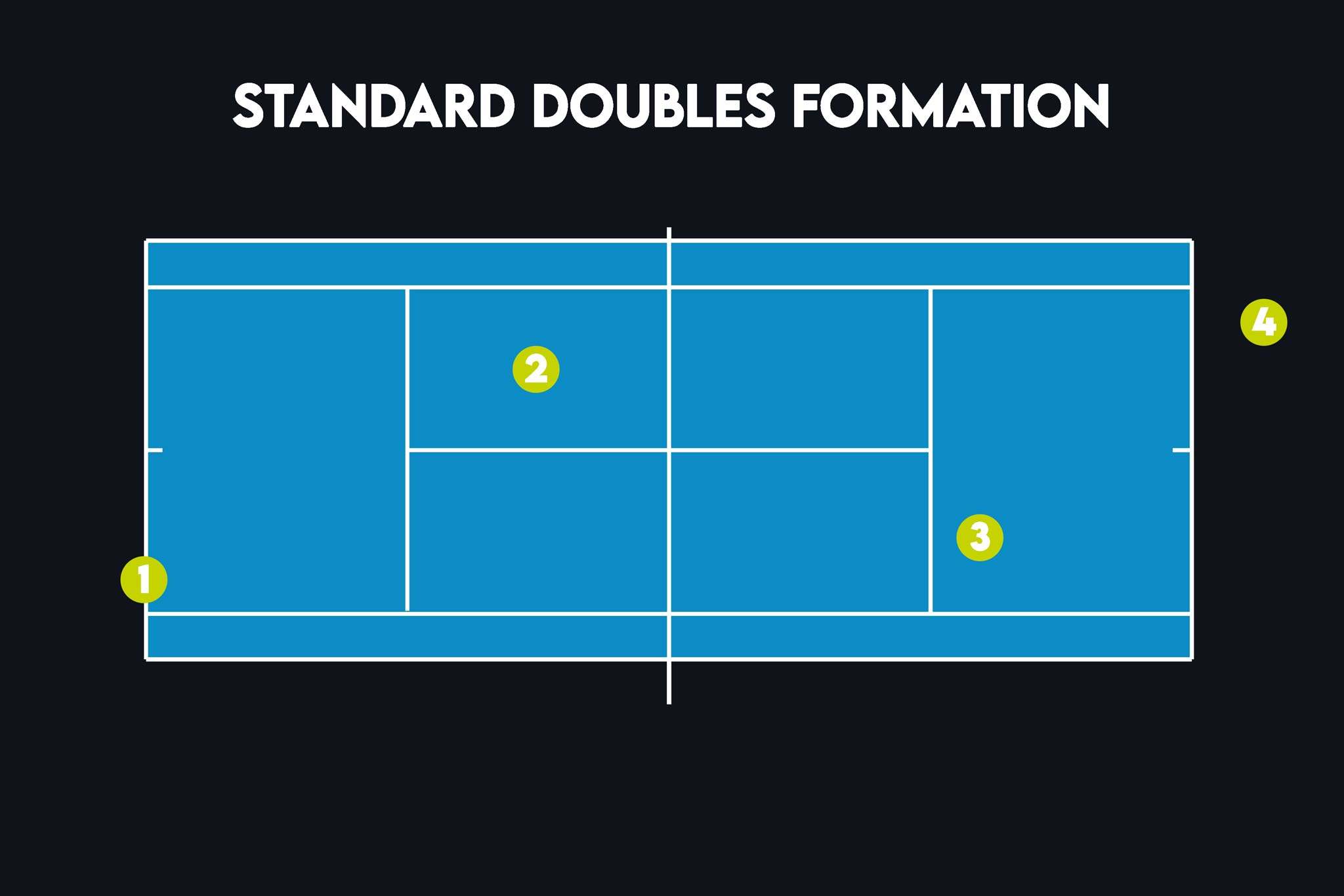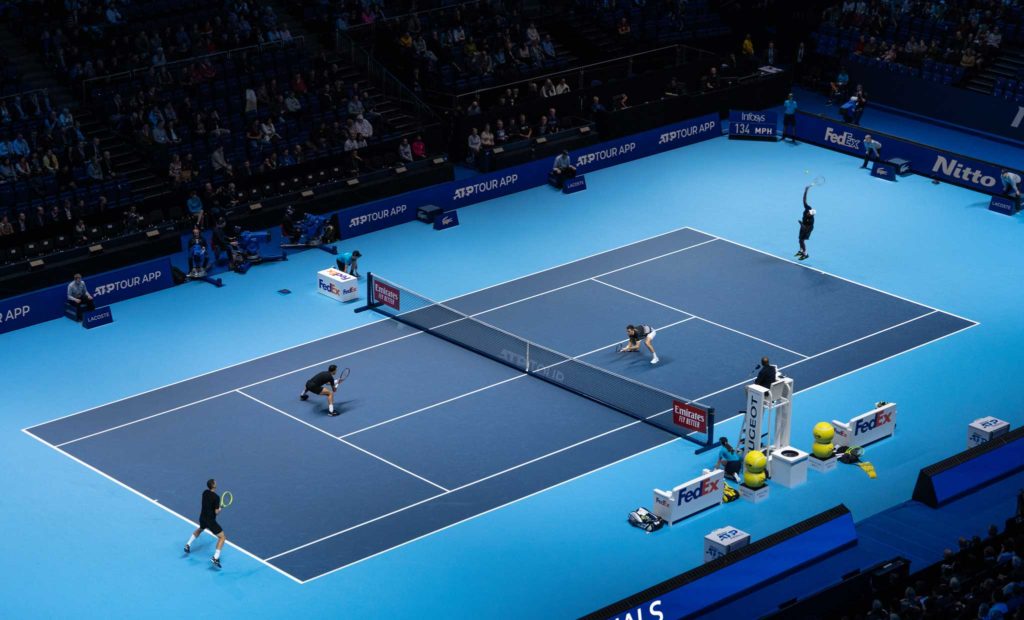Doubles tennis is a very different game to singles. You’re playing on a slightly bigger court and spending more time at the net, but most importantly, you’ll be playing and communicating with a partner, which can make it a more complex game. So, we’ve put together a complete guide to doubles tennis strategy, including tactics and tips to take your doubles game to the next level.
Doubles Tennis Positioning & Formations
First of all, you’ll want to make sure you’re positioned correctly and are moving to the right place. Here are a few tips on where you should usually stand if you are using a standard doubles formation and how to move:

- When serving, stand a couple of feet from the doubles alley. That will allow you to comfortably cover your half of the court and handle any wider returns.
- When your partner is serving, stand near the centre of the service box on the other half of the court. That puts you in a good position to hit volleys at the right height and will allow you to cover the tramline on your side of the court. It also puts you in a good position to cover a lob if the ball goes over your head.
- If your partner is returning, stand a little behind the service line. That way you’ll be able to cover the court if the opponent gets a volley, or move forward to volley yourself.
- If you are retuning a serve, stand as you would for a return in singles, but stand a little closer to the doubles alley to cover a wider serve.
These are positions used in the standard doubles formation. If you use more advanced doubles formations, you’ll want to adapt your positioning. Below, you’ll find an overview of each of the doubles formations, including the advantages and disadvantages that each brings and exactly when to use each of them.
The Standard Doubles Formation
The standard formation is the most commonly used in doubles at all levels of the game. It involves both teams having one player at the baseline and one player at the net. The net players stand diagonally across the court from each other, which creates space for crosscourt rallies between the baseliners.
Advantages: it’s a rather neutral formation, which allows you to cover the court well without leaving any big spaces for your opponents to hit into. It also allows you to be offensive and defensive at the same time as the net player can be aggressive while the baseliner can cover deeper crosscourt shots and lobs.
Disadvantages: It can be a little too neutral. If your net player isn’t aggressive enough, it will allow your opponents to rally comfortably crosscourt and work their way to the net.
When to use it: as it suits most players and scenarios, we’d recommend using the standard formation most of the time and occasionally using more advanced tactics to shake things up a bit.

The I-Formation
The I formation is a more advanced doubles formation which involves the net player standing on, or very close to, the centre service line and the server standing close to the centre of the baseline. Before the point starts, players will agree on which direction the net player will move. This is usually done using hand signals and allows the net player to be more aggressive at the net and the server to cover the other half of the court.
Advantages: it allows the net player to be more aggressive when trying to poach, giving you an edge at the net. It also helps to confuse opponents as they won’t know where the net player is going to be.
Disadvantages: by being more aggressive, the net player will be leaving more of the court open and will be exposed to return shots down the line.
When to use it: it’s best used when your opponent’s are very comfortable on returning cross court and are able to keep the ball away from the net player.
The Australian Formation
The Australian formation is another advanced doubles serving strategy in which both players line up on the same side of the court, leaving half of the court exposed. It’s a very aggressive formation that is used to force the opponents to hit returns down the line.
Advantages: by lining up on the same side as the server, the net player can cover the cross-court return much better. That pretty much forces them to return down the line, which is a more difficult shot.
Disadvantages: obviously, you’re leaving half of the court open. That can be a huge risk if your opponents have a decent return down the line or if the server doesn’t hit a great serve.
When to use it: when your opponent’s are very good at returning cross-court and you want to force the return down the line.
The "Two Back" Formation
Playing with two players at the back of the court is a tactic most commonly used on return when you or your partner are being bullied at the net. It’s particularly useful against big serves when you’re struggling to get the return back.
Advantages: playing with two players back gives you more time to react to your opponent’s shots and can be very useful if you and your partner are being bullied at the net on return.
Disadvantages: by playing with two players at the back you’re giving your opponents more space to hit into, so you’ll be relying on getting a little more on your returns.
When to use it: when you’re getting bullied at the net on return.
6 Basic Tennis Doubles Tactics
Here are a few basic strategies that are essential in doubles and are effective at almost every level of the game:
1. Avoid the Net Player
Generally speaking, you’ll want to avoid the opposing net player. They are in a position to finish the point if they can get their racket on the ball. So instead, try to keep the ball away from them when you’re rallying from the baseline. By doing that, you keep the rally going and give your partner a chance to be aggressive at the net.
2. Hit to the Weaker Player's Backhand
It goes without saying that hitting to the weaker opponent will likely win you more points. But you should also try hitting to the weaker player’s backhand as that will usually be their weakest shot. The same goes for their volleys. More often than not, your opponents will make more mistakes from backhand volleys than forehand volleys too.
3. Hit Groundstrokes Deep in the Court
If you’re rallying with an opponent from the baseline, try to keep your groundstrokes deep as it will keep your opponent pinned back and won’t allow them to get to the net. Hitting deep is also more likely to force a mistake and allow your partner to put away a volley at the net.
4. Hit the Ball to the Net Player's Feet
If you get a chance to attack and be aggressive, aim for the opposing net player’s feet. Hitting a volley from your feet is much more difficult than a regular volley at chest height. Even if your opponents are very good volleyers, it will be extremely difficult for them to hit an aggressive shot since they will be volleying from below the height of the net. And if they manage to get the ball back it will likely just float back over the net for your partner to put the ball away.
That’s why aiming at the net player’s feet is a great way to force an error from your opponents.
5. Attack the Middle of the Court
If you find yourself at the baseline with both opponents at the net, attack the middle of the court, rather than trying more difficult shots like a passing shot down the line or a lob.
By hitting to the middle, you’re forcing your opponents to quickly decide who’s getting the ball and can often cause confusion between them. It also makes it much more difficult for them to hit a winning volley as they’ll have fewer angles to work with.
6. Take Control of the Net
Taking the net is one of the most common and effective doubles tennis strategies.
It’s a great way of taking control of the point, being aggressive and putting your opponents under pressure. It takes time away from them and gives them much less space to hit into, forcing them go for riskier shots like passing shots down the line or even lobs.
Doubles Strategy At The Net
You’re going to be spending a lot of time at the net, so coming up with a good net strategy can make or break a match. There are generally three tactics you can consider when you’re at the net:
- Poaching: a poach is simply when the net player crosses onto the other side of the centre service line to cut the rally off and hit a volley. It tends to work well at the beginning of a match as not many players will return down the line early on. And if your partner can expose their weakness with the serve, you should get a relatively easy volley.
- Pinching: this is when a player moves diagonally towards the middle of the net to close down the space in a cross court rally. It’s particularly useful to force errors from your opponents by making them go for more difficult shots.
- Faking: this one is pretty self explanatory. Faking is when you act like you’re going to poach, but instead recover towards the doubles alley. The key here is making sure that your opponent sees you move, so set off early to give you time to recover and catch their shot down the line. This is a great way of forcing errors from the returner or getting a fairly simple volley to put away.
Just keep in mind that pinching and faking are tactics that leave your half of the court partially exposed, so be sure to use them carefully.
Once you’ve got a volley, you’ll usually want to volley into space, assuming there is one. If both opponents are well positioned or are at the net, aim for the middle and hit to their feet.
Doubles Strategy On Serve
Serving in doubles is very much focused on setting you partner up for a volley, rather than winning the game with aces. To do that, you’ll want to communicate with your partner and agree on a serve strategy. For starters, you’ll want to let your partner know where you’re going to serve to, either by telling them at the baseline or using hand signals.
Then, there are two tactics you can consider:
- Serve to your opponent’s weakness, which will usually be their backhands. As the match goes on, you may start to notice that they have a weaker forehand return, or that they can’t return down the line. You may even notice that they struggle more with slower second serves than with your first serves.
- Serve to your strengths is you can’t find their weakness. Either use your most effective serve or the serve that is more likely to set your partner up for a volley. More often than not, serving down the T can reduce the angles you’ll face on the return and allow your partner to poach.
An effective serve strategy will also allow you to serve and volley a lot more successfully and put your opponents under pressure right away.
Doubles Strategy On Return
Of course, serving is only half the game. Unlike singles, a weak return in doubles will be put away by the opposing net player with ease. So, having a good return strategy can be crucial to effectively making a high percentage of good returns.
One of the most common mistakes in doubles is trying to go for too much on the return. Before you start going for big returns down the line or really wide shots into the baseline, focus on getting the ball back and away from the net player. After all, your goal shouldn’t be to hit a winner off of the return, but rather to get into the point and set your partner up for a volley.
One of the most effective strategies when returning is to aim for the middle strap. That’s because:
- It’s the lowest part of the net, which means you’ll have a slightly bigger margin for errors.
- You’re taking away the angles, making it more difficult for your opponents to hit a winning volley.
- You’re keeping the ball low. Even if your opponent decides to serve and volley, you’ll be hitting the return to their feet and they’ll be hitting a much more difficult first volley.
If you see the opposing net player trying to be more aggressive, be sure to go down the line with your return every now and then to keep them in check and stop them from poaching too often.
All of these strategies take time to perfect and may not work all of the time. The key though is in winning more than you lose. Find what works best for you and your partner and what allows you to keep your opponents under pressure and eventually win matches.


